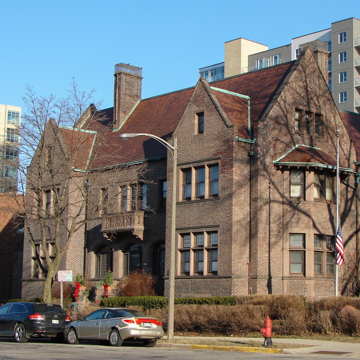The dignified but austere exterior of this former house relies very little on ornament or stylistic detail. Instead, it emphasizes careful attention to massing brick, sandstone, and other building materials. Eschweiler’s rendition of Tudor Revival is executed with almost obsessive restraint. Only plain limestone dressings interrupt the dark brick walls. This spare exterior does nothing to prepare visitors for the sumptuous, nearly intact interior featuring marble and alabaster fittings, hand-rubbed mahogany woodwork, English-style ornamental plasterwork, and a magnificent hand-wrought bronze staircase balustrade. State-of-the-art technology went into its construction. It is said that Charles Allis intended his house to become an art museum after his death, so to protect his collection, he requested a fireproof structure. The brick and stone walls conceal a steel frame, the floors are poured concrete, and the foundation rests on fifty-foot-deep piles. The house reflects the same industrial mentality that Allis applied to the Allis-Chalmers Company, one of the world’s largest heavy machinery manufacturers. In 1946, the house became a museum displaying the Allis family’s Asian porcelain, bronze sculptures, paintings, and antique furniture.
You are here
Charles Allis Art Museum (Charles and Sarah Allis House)
If SAH Archipedia has been useful to you, please consider supporting it.
SAH Archipedia tells the story of the United States through its buildings, landscapes, and cities. This freely available resource empowers the public with authoritative knowledge that deepens their understanding and appreciation of the built environment. But the Society of Architectural Historians, which created SAH Archipedia with University of Virginia Press, needs your support to maintain the high-caliber research, writing, photography, cartography, editing, design, and programming that make SAH Archipedia a trusted online resource available to all who value the history of place, heritage tourism, and learning.





















